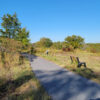calsfoundation@cals.org
Homelessness
Large numbers of homeless people live in Arkansas. Looking at data for people who received a funded service, emergency shelter, or transitional shelter from the U.S. Department of Housing and Urban Development (HUD), the Arkansas Management Information System found that 22,000 people were homeless at some point during 2006 in Arkansas. A statewide count on January 24, 2007, of people housed in shelters, along with an observational count on the streets and in camps, determined that 7,400 to 8,000 Arkansans are homeless on any given night.
The Arkansas Homeless Coalition completed a survey in 2005 among the homeless who congregate under bridges and frequent the soup kitchens in the Little Rock (Pulaski County) area. One hundred survey responses documented that forty percent of these homeless persons are engaged in some type of employment. The jobs were minimum wage, part time, or temporary day labor. The same survey documented that twenty-five percent of those surveyed received disability benefits. Veterans make up sixteen percent of those homeless persons receiving disability benefits. The majority of the disabled homeless receive just over $600 per month. They must often choose between medicine, food, or housing. Although those who qualify for supplemental security income are eligible for Medicaid, the co-pay for those served under this program often prohibits their ability to purchase medications, even if the co-pay is as small as five dollars. Hospitals turn homeless patients away for reasons such as prior unpaid co-pays or the inability to pay for service unless they are experiencing a life-threatening event when they present at an emergency room. For homeless people who have the functional capacity to apply for and receive food stamps, the stamps’ value is small, and people on the streets often sell these for a few cents on the dollar. In addition to these barriers, the homeless who are living in shelters or on the streets are often robbed or just do not have the ability to secure money or other items. People who are mentally ill or under the influence of addiction are the most vulnerable among the homeless population.
Demographics of the homeless and chronically homeless in Arkansas are diverse:
| Central Arkansas* | National Average | |
| Chronic Homelessness | 40% | 30% |
| Severe Mental Illness | 26% | 22% |
| Chronic Substance Abuse | 66% | 34% |
| Veterans | 21% | 11% |
| Persons with HIV/AIDS | 7% | 20% |
| Victims of Domestic Violence | 13% | 34% |
| Youth (Under 18 years of age) | 21% | 25% |
* Central Arkansas demographics reflect only those in shelters in 2005.
A variety of problems can cause homelessness, the primary cause being a severe lack of affordable housing in Arkansas for people with low incomes. Secondary causes include mental illness, physical illness, substance abuse, lack of incentive to work, poor work ethic, and lack of appropriate education. In many cases, people are in and out of the homeless system, which includes shelters, hospitals, the streets, and prisons. A deficit of homeless shelters leaves an estimated forty-five percent homeless Arkansans sleeping outdoors, in vacant or abandoned buildings, in cars, and in other locations not meant for human habitation.
Arkansas is experiencing a dearth of affordable housing. For example, professionals and corporate workers have moved to northwest Arkansas to benefit from employment through entities such as Walmart Inc., Tyson Foods, J. B. Hunt, and other Arkansas-based corporations that have created wealth for many of their top managers. In 2005, the average price of a house in this area of the state was $150,000, and the average rent was $579 a month. Affordable housing has been razed to build homes for highly paid executives and professionals that demand more and more in size and quality in the homes they purchase. For people living on slightly more than $600 per month, this is completely out of reach, and thus many people who work in minimum wage jobs are forced to live outside city limits in substandard housing, are homeless, or live in shared housing that is neither private nor safe in many cases. Northwest Arkansas is an extreme example of the lack of affordable housing in the state, but this area has set a standard of housing development that is being followed throughout the state. Downtown warehouses are being renovated into expensive condominiums, and affordable housing communities are being leveled to provide the space for the development of gated housing for the wealthy. Little has been put on the drawing board to ensure that any type of affordable housing is provided as replacement housing for the poor.
Noted from a 2004 University of Arkansas at Little Rock (UA Little Rock) study, the services homeless people most need include transportation (seventy-four percent), assistance in locating a place to live (seventy-two percent), and help in finding services or case management (seventy percent). Respondents who reported being chronically homeless as per HUD guidelines were most likely to report needing medical treatment (fifty-seven percent), in comparison to the situational homeless and family units who are experiencing homelessness for a short period of time due to some recent negative event in their life, (forty-two percent and thirty-two percent, respectively). Help with financial credit, dental services, job searches, job training, and a place to go during the day were each indicated as needed by more than half of the sample.
Most people become homeless specifically because they are having a housing crisis, even though they may have other needs for additional services and for increased incomes. Needs for additional services include substance abuse treatment and mental illness stabilization through medication, vocational training, etc. A count of the homeless population in Arkansas for the past five years indicates an increase every year of a minimum of two percent. In 2004, the National Coalition for the Homeless named Little Rock as the meanest city in the United States to the homeless. This designation was based on actions taken by the city to motivate the homeless to leave the downtown area. Actions included destruction of homeless camps and the battering of many homeless persons. In recent years, a shift has occurred among the city leaders.
A Mayor’s Commission on Homelessness has been named, and this commission oversaw the opening of a homeless day resource center in North Little Rock (Pulaski County), funded by both Little Rock and North Little Rock, in November 2008. Affordable housing remains the chief means of moving the homeless from the streets, and housing trust funds are being viewed for new legislation to create affordable units for the disabled and the working poor. The media and the public have created this shift from abusing the homeless to creating programs to assist the homeless.
For additional information:
Davis, Andy. “At Forum, Homeless Tell of Life on the Street.” Arkansas Democrat-Gazette, July 12, 2007, pp. 1B, 7B.
Fitzpatrick, Kevin M. “Circumstances, Religiosity/Spirituality, Resources, and Mental Health Outcomes among Homeless Adults in Northwest Arkansas.” Psychology of Religion and Spirituality 10 (November 2017): 195–202. Online at https://www.researchgate.net/publication/321324869_Circumstances_ReligiositySpirituality_Resources_and_Mental_Health_Outcomes_Among_Homeless_Adults_in_Northwest_Arkansas (accessed January 25, 2023).
Gibson, Reilly. “Alcohol Abuse and Misuse amongst Homeless Persons in Northwest Arkansas.” MA thesis, University of Arkansas, 2021. Online at https://scholarworks.uark.edu/etd/3982/ (accessed January 25, 2023).
Hall, Rebekah. “Looking for a Hot and a Cot.” Arkansas Times, November 8, 2018, pp, 14–18. Online at https://www.arktimes.com/arkansas/looking-for-a-hot-and-a-cot-in-little-rock/Content?oid=25323789 (accessed January 25, 2023).
Hudson, Stacey. “Group’s Count Finds Rise in Homelessness.” Arkansas Democrat-Gazette, July 21, 2007, pp. 1A, 9A.
Krupa, John. “UA Report Paints Picture of Homeless in State’s NW.” Arkansas Democrat-Gazette, July 18, 2007, p. 9B.
Monk, Ginny. “Rehousing for the Homeless Lacking.” Arkansas Democrat-Gazette, October 22, 2018, pp. 1A, 8A.
National Coalition for the Homeless. http://www.nationalhomeless.org (accessed January 25, 2023).
O’Connor, Gail, and Kevin Fitzpatrick. “Do Place and Time Make a Difference? Examining Quality of Life among Homeless Persons in Northwest Arkansas and Birmingham.” Community Mental Health Journal 53 (2017): 334–339.
Price, Tyre Mica. “A Qualitative Examination of Homeless LGBTQ+ Adults in Arkansas.” MA thesis, University of Arkansas at Little Rock, 2020.
Sullivan, Nichelle. “Homelessness in Arkansas.” MA thesis, University of Arkansas, 2015. Online at https://scholarworks.uark.edu/etd/1189/ (accessed January 25, 2023).
Sandra R. Wilson
Arkansas Homeless Coalition
 Gillam Park
Gillam Park Lucie's Place
Lucie's Place




As a voice for homeless people, I think they still are never really seen by people in our communities. If so, then why do so many homeless people walk our streets? I do take in the homeless people when I can and visit the mission often.